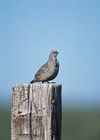Genus Callipepla

California Quail - These birds have a curving crest or plume, made of six feathers, that droops forward: black in males and brown for females; the flanks are brown with white streaks. Males have a dark brown cap and a black face with a brown back, a grey-blue chest and a light brown belly. Females and immature birds are mainly grey-brown with a light-colored belly. Their closest relative is Gambel's Quail which has a more southerly distribution and, a longer crest , a brighter head and a scalier appearance. The two species separated about 1-2 million years ago, during the Late Pliocene or Early Pleistocene.
Arizona quail - These birds are easily recognized by their top knots and scaly plumage on their undersides. Gambel's quail have gray plumage on much of their bodies, and males have copper feathers on the top of their heads, black faces, and white stripes above their eyes. Gambel's quail can be commonly confused with California Quail due to similar plumage. They can usually be distinguished by range, but when this does not suffice, California quail have a more scaly appearance and the black patch on the lower breast of the male Gambel's Quail is absent in the California Quail. The two species are sister taxa which diverged during the Late Pliocene or Early Pleistocene, 1 to 2 mya .
Scaled quail - Ortyx squamatus Vigors, 1830



